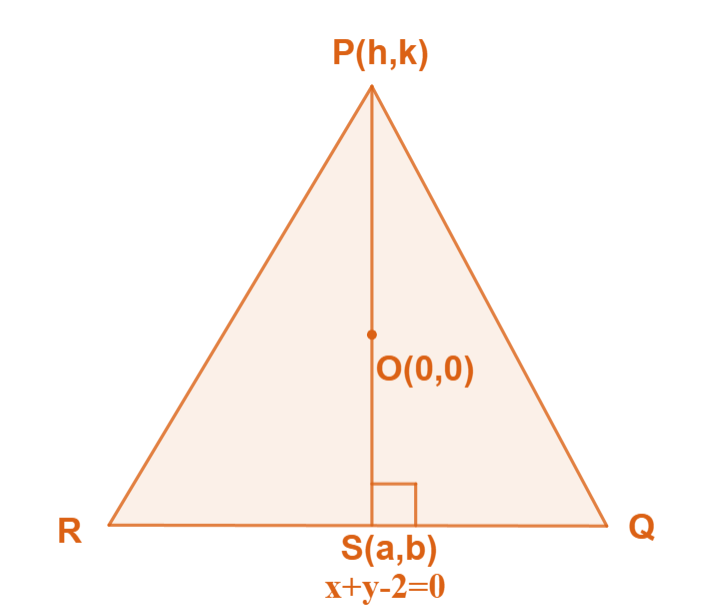
One vertex of the equilateral triangle with a centroid at the origin and one side as $x+y-2$ is
A. $(-1,-1)$
B. $(2,2)$
C. $(-2,-2)$
D. None of these
Answer
217.2k+ views
Hint: For this, we need to go through the concept of median in a triangle and their ratio in which they divide each other. Also, we know the concept that the perpendicular lines' slopes are their opposite reciprocals.
Formula Used: The line segment connecting points $A$ and $B$ is internally divided by a point $P$ whose coordinates are $(x,y)$ in the ratio $m_1\colon\:m_2$ is given by the Section formula:
$(x,y)=(\dfrac{m_1x_2+m_2x_1}{m_1+m_2},\dfrac{m_1y_2+m_2y_1}{m_1+m_2})$
Complete step by step solution: Let $\triangle PQR$ be the equilateral triangle with centroid $O$ at the origin.
$PS \bot RQ$

Given the equation of side, $RQ$ is
$x+y-2=0 …(i)$
Slope of $x+y-2=0$ is $-1$.
As you can see the centroid $O$ of an equilateral triangle divides $PS$ in the ratio of $2\colon1$.
So, using the Section Formula we get
$0=\dfrac{1\times h+2\times a}{1+2}\\
h+2a=0 ...(ii)$
Also,
$0=\dfrac{1\times k+2\times b}{1+2}\\
k+2b=0 ...(iii)$
Point $S$ passes through $(a,b)$ and lies on the line $x+y-2=0$
Therefore,
$a+b-2=0$
The slope of $PO$
$=\dfrac{k-0}{h-0}\\
=\dfrac{k}{h}$
Since $PS \bot RQ$ So,
$-1\times \dfrac{k}{h}=-1\\
h=k$
From eq (ii) and (iii) we get
$h+2a=0\\
\Rightarrow2a=-h$
And
$k+2b=0\\
\Rightarrow2b=-k\\
\therefore a=b$
Substitute $a=b$ in $a+b-2=0$
$\Rightarrow a+a-2=0\\
\Rightarrow 2a-2=0\\
a=1;b=1$
Substitute the values of $a$ and $b$ to obtain the vertex
$h=-2\times1=-2$
$k=-2\times1=-2$
Hence, the required vertex is $(-2,-2)$.
So, option C is correct.
Note: The coordinate order is extremely important in the ordered pair $(x,y)$. Keep in mind that x stands for the x coordinate and y for the y-coordinate. When substituting in the formula, keep in mind that the order in which the points are taken into account and the ratio is important. Frequent mistakes include miscalculating the slope of a parallel and perpendicular line.
Formula Used: The line segment connecting points $A$ and $B$ is internally divided by a point $P$ whose coordinates are $(x,y)$ in the ratio $m_1\colon\:m_2$ is given by the Section formula:
$(x,y)=(\dfrac{m_1x_2+m_2x_1}{m_1+m_2},\dfrac{m_1y_2+m_2y_1}{m_1+m_2})$
Complete step by step solution: Let $\triangle PQR$ be the equilateral triangle with centroid $O$ at the origin.
$PS \bot RQ$

Given the equation of side, $RQ$ is
$x+y-2=0 …(i)$
Slope of $x+y-2=0$ is $-1$.
As you can see the centroid $O$ of an equilateral triangle divides $PS$ in the ratio of $2\colon1$.
So, using the Section Formula we get
$0=\dfrac{1\times h+2\times a}{1+2}\\
h+2a=0 ...(ii)$
Also,
$0=\dfrac{1\times k+2\times b}{1+2}\\
k+2b=0 ...(iii)$
Point $S$ passes through $(a,b)$ and lies on the line $x+y-2=0$
Therefore,
$a+b-2=0$
The slope of $PO$
$=\dfrac{k-0}{h-0}\\
=\dfrac{k}{h}$
Since $PS \bot RQ$ So,
$-1\times \dfrac{k}{h}=-1\\
h=k$
From eq (ii) and (iii) we get
$h+2a=0\\
\Rightarrow2a=-h$
And
$k+2b=0\\
\Rightarrow2b=-k\\
\therefore a=b$
Substitute $a=b$ in $a+b-2=0$
$\Rightarrow a+a-2=0\\
\Rightarrow 2a-2=0\\
a=1;b=1$
Substitute the values of $a$ and $b$ to obtain the vertex
$h=-2\times1=-2$
$k=-2\times1=-2$
Hence, the required vertex is $(-2,-2)$.
So, option C is correct.
Note: The coordinate order is extremely important in the ordered pair $(x,y)$. Keep in mind that x stands for the x coordinate and y for the y-coordinate. When substituting in the formula, keep in mind that the order in which the points are taken into account and the ratio is important. Frequent mistakes include miscalculating the slope of a parallel and perpendicular line.
Recently Updated Pages
Area vs Volume: Key Differences Explained for Students

Mutually Exclusive vs Independent Events: Key Differences Explained

Addition of Three Vectors: Methods & Examples

Addition of Vectors: Simple Guide for Students

Algebra Made Easy: Step-by-Step Guide for Students

Relations and Functions: Complete Guide for Students

Trending doubts
JEE Main 2026: Application Form Open, Exam Dates, Syllabus, Eligibility & Question Papers

Derivation of Equation of Trajectory Explained for Students

Hybridisation in Chemistry – Concept, Types & Applications

Understanding the Angle of Deviation in a Prism

Understanding Collisions: Types and Examples for Students

How to Convert a Galvanometer into an Ammeter or Voltmeter

Other Pages
JEE Advanced Marks vs Ranks 2025: Understanding Category-wise Qualifying Marks and Previous Year Cut-offs

NCERT Solutions for Class 11 Maths Chapter 10 Conic Sections

NCERT Solutions for Class 11 Maths Chapter 9 Straight Lines

NCERT Solutions For Class 11 Maths Chapter 8 Sequences And Series

Understanding Atomic Structure for Beginners

NCERT Solutions For Class 11 Maths Chapter 12 Limits And Derivatives




